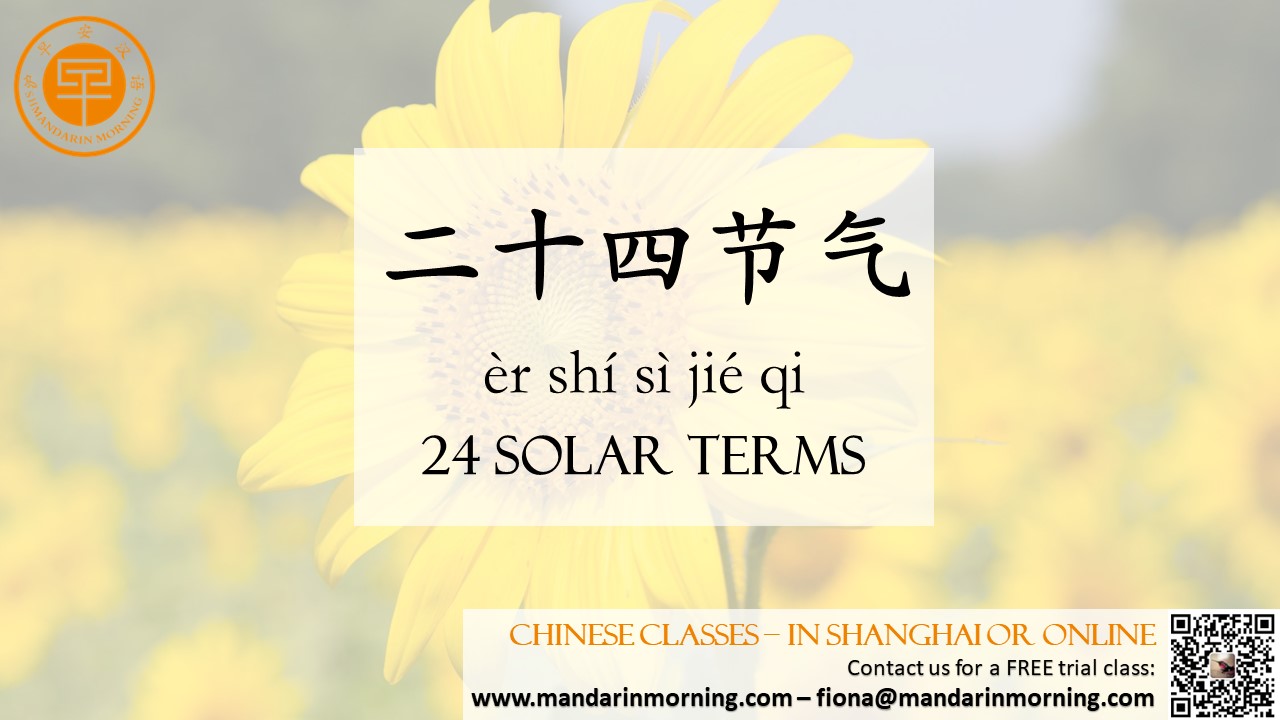Solar Terms 二十四节气 (èr shí sì jié qi) is a calendar of twenty-four periods and climate to govern agricultural arrangements in ancient China and functions even now. Each solar term has about 15 days and it is decided by the position of the sun in the sky. How Does it Work? These twenty-four solar terms each suggest the position of the sun every time it travels 15 degrees on the ecliptic longitude. A cycle is that earth revolves around the sun for one time. It begins from the Beginning of Spring (Li Chun) and ends at Greater Cold (Da Han). In each month there are often two solar terms; the first one is generally named 'Jie Qi' and the other one 'Zhong Qi'. Their dates are mirrored by the Gregorian calendar, so we find that during the first half of a year 'Jie Qi' is around the 6th day of a solar month, 'Zhong Qi' around the 21st; in the second half of a year, 'Jie Qi' is around the 8th and 'Zhong Qi' around the 23rd. Meanings of 24 Solar Terms These solar terms have meaningful titles. Some of them reflect the change of seasons such as the Beginning of Spring, the Beginning of Summer, the Beginning of Autumn, and the Beginning of Winter; some embody the phenomena of climate like the Waking of Insects (Jing Zhe), Pure Brightness (Qing Ming), Lesser Fullness of Grain (Xiao Man) and Grain in Beard (Mang Zhong); and some indicate the change of climate like Rain Water (Yu Shui), Grain Rain (Gu Yu), Lesser Heat (Xiao Shu), Greater Heat (Da Shu), and so on. History and Origin During the Shang Dynasty (17th century BC - 1046 BC), ancient people have decided 4 solar terms: The Spring Equinox (Chun Fen), The Summer Solstice (Xia Zhi), The Autumn Equinox (Qiu Fen), The Winter Solstice (Dong Zhi) by observing the shadow at noon. When the shadow is shortest in a year, it is Summer Solstice, the longest is Winter Solstice and the moderate is Spring Equinox or Autumn Equinox. In Zhou Dynasty (11th century BC - 221BC), eight solar terms were used. In 104 BC, the astronomical positions of 24 solar terms were decided. Here is a list of all 24 solar terms and their dates in 2022: Lesser Cold (Xiao Han) - Jan. 5th Greater Cold (Da Han) - Jan. 20th The Beginning of Spring (Li Chun) - Feb. 4th Rain Water (Yu Shui) - Feb. 19th The Waking of Insects (Jing Zhe) - Mar. 5th The Spring Equinox (Chun Fen) - Mar. 20th Pure Brightness (Qing Ming) - Apr. 5th Grain Rain (Gu Yu) - Apr. 20th The Beginning of Summer (Li Xia) - May 5th Lesser Fullness of Grain (Xiao Man) - May 21st Grain in Beard (Mang Zhong) - Jun. 6th The Summer Solstice (Xia Zhi) - Jun. 21st Lesser Heat (Xiao Shu) - Jul. 7th Greater Heat (Da Shu) - Jul. 23rd The Beginning of Autumn (Li Qiu) - Aug. 7th The End of Heat (Chu Shu) - Aug. 23rd White Dew (Bai Lu) - Sep. 7th The Autumn Equinox (Qiu Fen) - Sep. 23rd Cold Dew (Han Lu) - Oct. 8th Frost's Descent (Shuang Jiang) - Oct. 23rd The Beginning of Winter (Li Dong) - Nov. 7th Lesser Snow (Xiao Xue) - Nov. 22nd Greater Snow (Da Xue) - Dec. 7th The Winter Solstice (Dong Zhi) - Dec. 22nd |